-

新人教版高中英语选修2Unit 3 Using langauge-Listening教学设计
1. How is Hunan cuisine somewhat different from Sichuan cuisine?The heat in Sichuan cuisine comes from chilies and Sichuan peppercorns. Human cuisine is often hotter and the heat comes from just chilies.2.What are the reasons why Hunan people like spicy food?Because they are a bold people. But many Chinese people think that hot food helps them overcome the effects of rainy or wet weather.3.Why do so many people love steamed fish head covered with chilies?People love it because the meat is quite tender and there are very few small bones.4.Why does Tingting recommend bridge tofu instead of dry pot duck with golden buns?Because bridge tofu has a lighter taste.5 .Why is red braised pork the most famous dish?Because Chairman Mao was from Hunan, and this was his favorite food.Step 5: Instruct students to make a short presentation to the class about your choice. Use the example and useful phrases below to help them.? In groups of three, discuss what types of restaurant you would like to take a foreign visitor to, and why. Then take turns role-playing taking your foreign guest to the restaurant you have chosen. One of you should act as the foreign guest, one as the Chinese host, and one as the waiter or waitress. You may start like this:? EXAMPLE? A: I really love spicy food, so what dish would you recommend?? B: I suggest Mapo tofu.? A: Really ? what's that?

新人教版高中英语选修2Unit 4 Learning about Language教学设计
This section guides students to pay attention to the typical context of vocabulary use, helps students accumulate vocabulary around the key vocabulary of this unit, and uses the learned words and word chunks in different contexts to deeply understand their meaning and usage, so as to achieve the purpose of review and consolidation.The teaching design activities aim to guide students to pay attention to the typical context in which the target vocabulary is used, as well as the common vocabulary used in collocation, so that students can complete the sentence with correct words. In terms of vocabulary learning strategies, this unit focuses on cultivating students' ability to pay attention to collocation of words and to use word blocks to express meaning.For vocabulary learning, it is not enough just to know the meaning of a single word, but the most important thing is to master the common collocations of words, namely word blocks.Teachers should timely guide students to summarize common vocabulary collocation, such as verb and noun collocation, verb and preposition collocation, preposition and noun collocation, and so on.1. Guide students to understand and consolidate the meaning and usage of the vocabulary in the context, 2. Guide the students to use the unit topic vocabulary in a richer context3. Let the students sort out and accumulate the accumulated vocabulary, establishes the semantic connection between the vocabulary,4. Enable students to understand and master the vocabulary more effectivelyGuiding the Ss to use unit topic words and the sentence patterns in a richer context.

新人教版高中英语选修2Unit 4 Reading for writing教学设计
假定你是英国的Jack,打算来中国旅行,请你给你的中国笔友李华写一封信,要点如下:1.你的旅行计划:北京→泰山→杭州;2.征求建议并询问他是否愿意充当你的导游。注意:1.词数80左右(开头和结尾已给出,不计入总词数);2.可以适当增加细节,以使行文连贯。参考词汇:故宫 the Forbidden City;泰山 Mount TaiDear Li Hua,I'm glad to tell you that 'm going to visit China.First,I am planning to visit Beijing,the capitalof China,where I am looking forward to enjoying the Great Wall,the Forbidden City and somebeautiful parks.Then I intend to go to visit Mount Tai in Shandong Province.I've heard that it is one ofthe most famous mountains in China and I can't wait to enjoy the amazing sunrise there.After that,I amalso going to Hangzhou.It is said that it is a beautiful modern city with breathtaking natural sights,among which the West Lake is a well- known tourist attraction.What do you think of my travel plan? Will you act as my guide? Hope to hear from you soon.

新人教版高中英语选修2Unit 4 Using langauge-Listening教学设计
The theme of the listening section is " talking about scenery and culture along a journey."The part is designed to further lead the students to understand Canadian natural geography and social environment, and integrated into the cultural contrast by mentioning the long train journey from Beijing to Moscow routes. On this basis, the part activates students related travel experience, lets the student serial dialogue, guides the student to explore further the pleasure and meaning of the long journey, and Chinese and foreign cultural comparison.The part also provides a framework for the continuation of the dialogue, which is designed to provide a framework for students to successfully complete their oral expressions, and to incorporate an important trading strategy to end the dialogue naturally.1. Help students to understand and master some common English idioms in the context, and experience the expression effect of English idioms.2. Guide the students to understand the identity of different people in the listening context, and finish the dialogue according to their own experience.3. Instruct the students to use appropriate language to express surprise and curiosity about space and place in the dialogue, and master the oral strategy of ending the dialogue naturally.1. Instruct students to grasp the key information and important details of the dialogue.2. Instruct students to conduct a similar talk on the relevant topic.

新人教版高中英语选修2Unit 5 Learning about Language教学设计
The purpose of this section of vocabulary exercises is to consolidate the key words in the first part of the reading text, let the students write the words according to the English definition, and focus on the detection of the meaning and spelling of the new words. The teaching design includes use English definition to explain words, which is conducive to improving students' interest in vocabulary learning, cultivating their sense of English language and thinking in English, and making students willing to use this method to better grasp the meaning of words, expand their vocabulary, and improve their ability of vocabulary application. Besides, the design offers more context including sentences and short passage for students to practice words flexibly.1. Guide students to understand and consolidate the meaning and usage of the vocabulary in the context, 2. Guide the students to use the unit topic vocabulary in a richer context3. Let the students sort out and accumulate the accumulated vocabulary, establishes the semantic connection between the vocabulary,4. Enable students to understand and master the vocabulary more effectivelyGuiding the Ss to use unit topic words and the sentence patterns in a richer context.Step1: Read the passage about chemical burns and fill in the blanks with the correct forms of the words in the box.

新人教版高中英语选修2Unit 5 Reading and thinking教学设计
The theme of this activity is to learn the first aid knowledge of burns. Burns is common in life, but there are some misunderstandings in manual treatment. This activity provides students with correct first aid methods, so as not to take them for granted in an emergency. This section guides students to analyze the causes of scald and help students avoid such things. From the perspective of text structure and collaborative features, the text is expository. Expository, with explanation as the main way of expression, transmits knowledge and information to readers by analyzing concepts and elaborating examples. This text arranges the information in logical order, clearly presents three parts of the content through the subtitle, accurately describes the causes, types, characteristics and first aid measures of burns, and some paragraphs use topic sentences to summarize the main idea, and the level is very clear.1. Guide students to understand the causes, types, characteristics and first aid methods of burns, through reading2. Enhance students’ ability to deal withburnss and their awareness of burns prevention3. Enable students to improve the ability to judge the types of texts accurately and to master the characteristics and writing techniques of expository texts.Guide students to understand the causes, types, characteristics and first aid methods of burns, through readingStep1: Lead in by discussing the related topic:1. What first-aid techniques do you know of ?CPR; mouth to mouth artificial respiration; the Heimlich Manoeuvre

新人教版高中英语选修2Unit 5 Using langauge-Listening教学设计
The theme of this section is to learn how to make emergency calls. Students should learn how to make emergency calls not only in China, but also in foreign countries in English, so that they can be prepared for future situations outside the home.The emergency telephone number is a vital hotline, which should be the most clear, rapid and effective communication with the acute operator.This section helps students to understand the emergency calls in some countries and the precautions for making emergency calls. Through the study of this section, students can accumulate common expressions and sentence patterns in this context. 1.Help students accumulate emergency telephone numbers in different countries and learn more about first aid2.Guide the students to understand the contents and instructions of the telephone, grasp the characteristics of the emergency telephone and the requirements of the emergency telephone.3.Guide students to understand the first aid instructions of the operators.4.Enable Ss to make simulated emergency calls with their partners in the language they have learned1. Instruct students to grasp the key information and important details of the dialogue.2. Instruct students to conduct a similar talk on the relevant topic.Step1:Look and discuss:Match the pictures below to the medical emergencies, and then discuss the questions in groups.

新人教版高中英语必修3Unit 1 Festivals and Celebrations教学设计三
*wide range of origins(= a great number of different origins, many kinds of origins)*It featured a parade and a great feast with music, dancing, and sports. (=A parade and a great feast with music, dancing, and sports were included as important parts of the Egyptian harvest festival.)*.. some traditions may fade away and others may be established.(= Some traditions may disappear gradually, while other new traditions may come into being.)Step 6 Practice(1) Listen and follow the tape.The teacher may remind the students to pay attention to the meaning and usage of the black words in the context, so as to prepare for the completion of the blanks in activity 5 and vocabulary exercises in the exercise book.(2) Students complete the text of activity 5 by themselves.The teacher needs to remind the students to fill in the blanks with the correct form of the vocabulary they have learned in the text.Students exchange their answers with their partners, and then teachers and students check their answers.(3)Finish the Ex in Activity 5 of students’ book.Step 7 Homework1. Read the text again, in-depth understanding of the text;2. Discuss the origin of festivals, the historical changes of related customs, the influence of commercial society on festivals and the connotation and essential meaning of festivals.3. Complete relevant exercises in the guide plan.1、通过本节内容学习,学生是否理解和掌握阅读文本中的新词汇的意义与用法;2、通过本节内容学习,学生能否结合文本特点快速而准确地找到主题句;3、通过本节内容学习,学生能否理清论说文的语篇结构和文本逻辑,了解节日风俗发展与变迁,感悟节日的内涵与意义。

新人教版高中英语必修3Unit 2 Morals and Virtues教学设计四
3.Teachers ask different groups to report the answers to the questions and ask them to try different sentence patterns.The teacher added some sentence patterns for students to refer to when writing.Step 4 Writing taskActivity 51.Write the first draft.Students first review the evaluation criteria in activity 5, and then independently complete the draft according to the outline of activity 4, the answers to the questions listed in the group discussion and report, and the reference sentence pattern.2.Change partners.The teacher guides the students to evaluate their partner's composition according to the checklist of activity 5 and proposes Suggestions for modification.3.Finalize the draft.Based on the peer evaluation, students revise their own compositions and determine the final draft.Finally, through group recommendation, the teacher selects excellent compositions for projection display or reading aloud in class, and gives comments and Suggestions.Step 5 Showing writingActivity 5T call some Ss to share their writing.Step 6 Homework1. Read the passage in this section to better understand the passage.2. Carefully understand the hierarchical structure of the article, and deeply understand the plot of the story according to the causes, process and results;3. Independently complete the relevant exercises in the guide plan.1、通过本节内容学习,学生是否理解和掌握阅读文本中的新词汇的意义与用法;2、通过本节内容学习,学生能否通过人物言行的对比分析道德故事的深层内涵;3、通过本节内容学习,学生能否根据故事的起因、经过和结果来深入理解故事的情节,从而了解文章的层次结构;4、结合现实生活案例发表自己的见解和看法,写一篇观点明确、层次分明的故事评论。
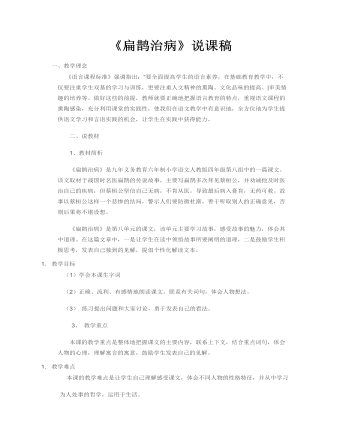
(新)部编人教版四年级上册《故事二则》说课稿(二)
一、教学理念《语言课程标准》强调指出:“要全面提高学生的语言素养,在基础教育教学中,不仅要注重学生双基的学习与训练,更要注重人文精神的熏陶、文化品味的提高、|审美情趣的培养等。做好这些的前提,教师就要正确地把握语言教育的特点,重视语文课程的熏陶感染,充分利用课堂的实践性,使我们在语文教学中有意识地,全方位地为学生提供语文学习和言语实践的机会,让学生在实践中获得能力。二、说教材1、教材简析《扁鹊治病》是九年义务教育六年制小学语文人教版四年级第八组中的一篇课文。该文取材于战国时名医扁鹊的传说故事,主要写扁鹊多次拜见蔡桓公,并劝诫他及时医治自己的疾病,但蔡桓公坚信自己无病,不肯从医,导致最后病入膏肓,无药可救。故事以蔡桓公这样一个悲惨的结局,警示人们要防微杜渐,善于听取别人的正确意见,否则后果将不堪设想。
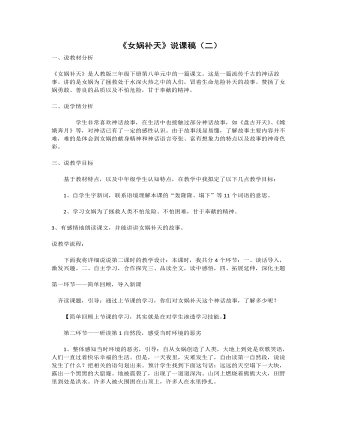
(新)部编人教版四年级上册《 女娲补天》说课稿(二)
下面我将详细说说第二课时的教学设计:本课时,我共分4个环节:一、谈话导入,激发兴趣。二、自主学习,合作探究三、品读全文,读中感悟,四、拓展延伸,深化主题第一环节——简单回顾,导入新课齐读课题,引导:通过上节课的学习,你们对女娲补天这个神话故事,了解多少呢?【简单回顾上节课的学习,其实就是在对学生渗透学习技能。】第二环节——研读第1自然段,感受当时环境的恶劣1、整体感知当时环境的恶劣,引导:自从女娲创造了人类,大地上到处是欢歌笑语,人们一直过着快乐幸福的生活。但是,一天夜里,灾难发生了,自由读第一自然段,说说发生了什么?把相关的语句划出来。预计学生找到下面这句话:远远的天空塌下一大块,露出一个黑黑的大窟窿。地被震裂了,出现了一道道深沟。山冈上燃烧着熊熊大火,田野里到处是洪水。许多人被火围困在山顶上,许多人在水里挣扎。
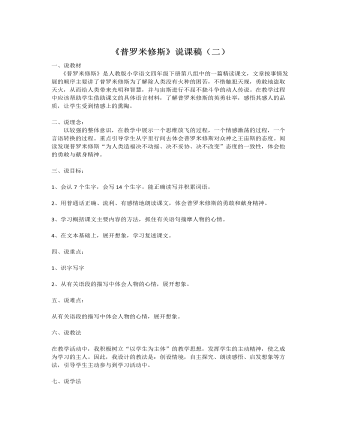
(新)部编人教版四年级上册《 普罗米修斯》说课稿(二)
第二课时 (一)、导入:中国古代神话传说中的女娲赋予人类生命,又为了人类幸福,历尽辛苦。而在古希腊神话故事中,也有一位带给人类幸福和光明的神,还记得他是谁吗?开启神话故事的窗口,激发阅读期待,激起学生对神话故事一种美的向往之情。 (二)、复习生词,学写生字通过分层设计复习词语,既使学生再现所学知识,又为学习新知识扫除障碍,重点强调“脏”是个多音字。指导书写:重点指导:“膝”“焰”“败”让学生整体观察字的特点,找出每个字的书写特点,力求将字写正确,写美观,同时注重书写反馈。(三)、直入重点,感悟“英雄”形象1采用大问题情境下的板块式教学模式,让学生默读课文,思考:你从哪些词句中感受到了普罗米修斯是一位英雄的?找一找,画一画,把感受写一写。然后检测学生对课文内容的理解,之后对本课进行深入的学习。
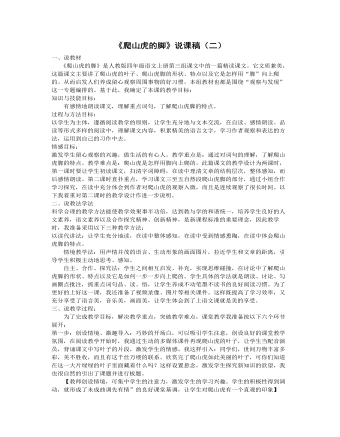
(新)部编人教版四年级上册《 爬山虎的脚》说课稿(二)
有感情地朗读课文,理解重点词句,了解爬山虎脚的特点。过程与方法目标:以学生为主体,遵循阅读教学的原则,让学生充分地与文本交流,在自读、感情朗读、品读等形式多样的阅读中,理解课文内容,积累精美的语言文字,学习作者观察和表达的方法,运用到自己的习作中去。情感目标:激发学生留心观察的兴趣,做生活的有心人。教学重点是:通过对词句的理解,了解爬山虎脚的特点。教学难点是:爬山虎是怎样用脚向上爬的。此篇课文的教学设计为两课时,第一课时要让学生初读课文,扫清字词障碍,在读中理清文章的结构层次,整体感知,而后感情朗读。第二课时直扑重点,学习课文三至五自然段爬山虎脚的部分,通过小组合作学习探究,在读中充分体会到作者对爬山虎的观察入微,而且是连续观察了很长时间。以下我着重对第二课时的教学设计作进一步说明。
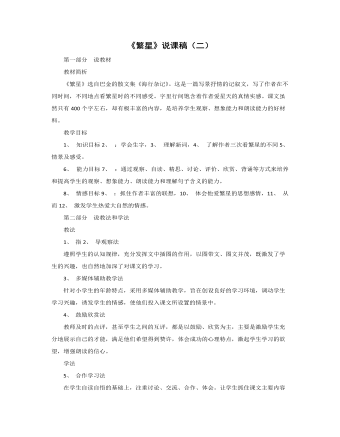
(新)部编人教版四年级上册《繁星》说课稿(二)
第一部分 说教材教材简析《繁星》选自巴金的散文集《海行杂记》。这是一篇写景抒情的记叙文,写了作者在不同时间,不同地点看繁星时的不同感受。字里行间饱含着作者爱星天的真情实感。课文虽然只有400个字左右,却有极丰富的内容,是培养学生观察、想象能力和朗读能力的好材料。教学目标1、 知识目标2、 :学会生字,3、 理解新词,4、 了解作者三次看繁星的不同5、 情景及感受。6、 能力目标7、 :通过观察、自读、精思、讨论、评价、欣赏、背诵等方式来培养和提高学生的观察、想象能力、朗读能力和理解句子含义的能力。8、 情感目标9、 :抓住作者丰富的联想,10、 体会他爱繁星的思想感情,11、 从而12、 激发学生热爱大自然的情感。
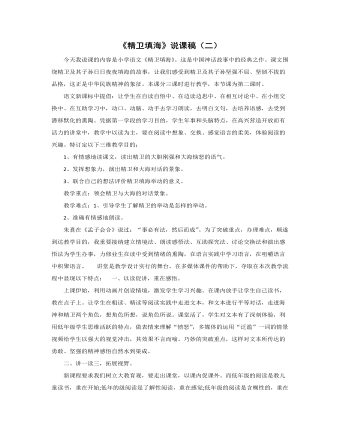
(新)部编人教版四年级上册《精卫填海》说课稿(二)
今天我说课的内容是小学语文《精卫填海》。这是中国神话故事中的经典之作。课文围绕精卫及其子孙日日夜夜填海的故事,让我们感受到精卫及其子孙坚强不屈、坚韧不拔的品格,这正是中华民族精神的象征。本课分三课时进行教学,本节课为第二课时。 语文新课标中提倡:让学生在自读自悟中、在边读边思中、在相互讨论中、在小组交换中、在互助学习中,动口、动脑、动手去学习朗读,去明白文句,去培养语感,去受到潜移默化的熏陶。凭据第一学段的学习目的,学生年事和头脑特点,在高兴营造开放而有活力的讲堂中,教学中以读为主,要在阅读中想象、交换、感觉语言的柔美,体验阅读的兴趣。特订定以下三维教学目的:
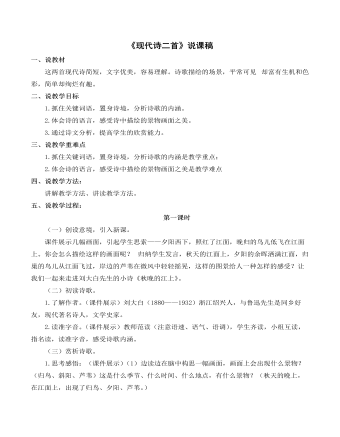
(新)部编人教版四年级上册《现代诗二首》说课稿
(一)创设意境,引入新课。 课件展示几幅画面,引起学生思索——夕阳西下,照红了江面,晚归的鸟儿低飞在江面上。你会怎么描绘这样的画面呢? 归纳学生发言,秋天的江面上,夕阳的余晖洒满江面,归巢的鸟儿从江面飞过,岸边的芦苇在微风中轻轻摇晃,这样的图景给人一种怎样的感受?让我们一起来走进刘大白先生的小诗《秋晚的江上》。(二)初读诗歌。 1.了解作者。(课件展示)刘大白(1880——1932)浙江绍兴人,与鲁迅先生是同乡好友,现代著名诗人,文学史家。 2.读准字音。(课件展示)教师范读(注意语速、语气、语调),学生齐读,小组互读,指名读,读准字音,感受诗歌内涵。(三)赏析诗歌。 1.思考感悟:(课件展示)(1)边读边在脑中构思一幅画面,画面上会出现什么景物?(归鸟、斜阳、芦苇)这是什么季节、什么时间、什么地点,有什么景物?(秋天的晚上,在江面上,出现了归鸟、夕阳、芦苇。)
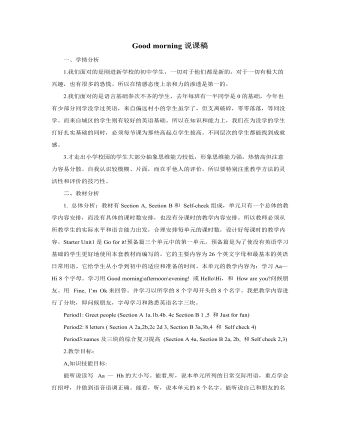
人教版新目标初中英语七年级上册Good morning说课稿
1.课堂活动中的竞赛制:以记奖评优的形式无声的评价每一个活动,包括个体和小群体。在第一课时评最佳演员和导演奖,第二课时评最佳团体奖,既节约时间又明确有效。使学生能提高语言质量,增强参与意识,提高学习兴趣。2. 教师课堂上语言、表情激励制:在课堂活动中教师要乐于 、善于用激励性语言。从good, super, smart, excellent , great ,wonderful等,用微笑,皱眉,摇头、点头等身体语言对于学生的评价是方便又有效的途径。3.课后作业评价:口头作业在第二天课堂上表演,接受全体同学的评价。笔头作业有教师批阅,以评语的方式出现。优秀作业予以展出或交流。积极地肯定和鼓励学生是我们评价的重要目的之一。4.单元结束后综合性评价:除了笔试以外,也可以根据学生实际开展丰富的活动,如:调查报告、小品表演、专题演讲等。

人教版高中历史必修2罗斯福新政说课稿2篇
1、教材的地位作用本课是新人教版普通高中历史必修Ⅱ第六单元第18课的内容,阐述罗斯福新政的背景、措施、影响。从单元知识安排看,本课与第17课《空前严重的资本主义世界经济危机》、19课《战后资本主义的新变化》共同诠释第六单元课题——《资本主义世界经济政策的调整》。说明了“资本主义经济理论和政策随着资本主义发展而不断调整的特点”,凸显了“市场调节”和“国家干预”在经济发展中的重要性。从知识体系看,它是学生学习了第一次工业革命后自由资本主义、第二次工业革命后的垄断资本主义等之后出现的,既是对上述知识的巩固与综合运用,又为学生学习必修二的相关内容打下基础,有承上启下的作用。本课三个子目从逻辑上看又是递进关系。第一个子目“临危受命”承上启下,说明了罗斯福上台的历史背景具有临危受命的特点,第二个子目“实施新政”讲述了罗斯福新政的主要内容,第三个子目“摆托危机困境”主要讲述了罗斯福新政的影响。

(新)部编人教版四年级上册《风筝》说课稿
六、说教学流程良好的教学设想必须通过教学实践来完成的,本课我预设两课时完成:第一课时:学习生字,初读课文,感知课文的主要内容,初步体会“我们”心情的变化。第二课时:感悟课文,体会“我们”“做风筝、放风筝、找风筝”时的心情变化,感悟童真童趣。我本次说课的内容是第二课时的教学。(一)复习导入1.听写词语:风筝 蝴蝶 拔几根 幸福 托着 垂头丧气 半圈树梢 歇一歇 千呼万唤 踪影 磨坊2. 这课文写出了作者童年做风筝放风筝时的快乐的情景。这节课让我们细细体会其中的快乐。(板书:风筝)(设计理念:由回忆放风筝的情景,引入课题,既锻炼了学生的表达能力,又勾起了他们美好的回忆,再次感受放风筝给他们带来的乐趣。让学生在已有生活经验基础上构建知识,使学生在不知不觉中感悟,培养学生在面对新知时,能主动寻找其现实背景的能力,激发了学生学习的积极性。)
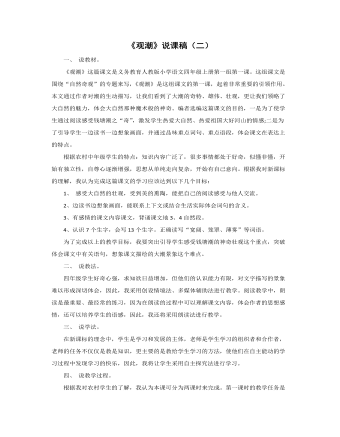
(新)部编人教版四年级上册 《观潮》说课稿(二)
一、 说教材。《观潮》这篇课文是义务教育人教版小学语文四年级上册第一组第一课。这组课文是围绕“自然奇观”的专题来写,《观潮》是这组课文的第一课,起着非常重要的引领作用。本文通过作者对潮的生动描写,让我们看到了大潮的奇特、雄伟、壮观,更让我们领略了大自然的魅力,体会大自然那种魔术般的神奇。编者选编这篇课文的目的,一是为了使学生通过阅读感受钱塘潮之“奇”,激发学生热爱大自然、热爱祖国大好河山的情感;二是为了引导学生一边读书一边想象画面,并通过品味重点词句、重点语段,体会课文在表达上的特点。根据农村中年级学生的特点:知识内容广泛了,很多事情都处于好奇,似懂非懂,开始有独立性,自尊心逐渐增强,思想从单纯走向复杂,开始有自己意向。根据我对新课标的理解,我认为完成这篇课文的学习应该达到以下几个目标:1、 感受大自然的壮观,受到美的熏陶,能把自己的阅读感受与他人交流。2、边读书边想象画面,能联系上下文或结合生活实际体会词句的含义。3、有感情的课文内容课文,背诵课文地3、4自然段。4、认识7个生字,会写13个生字。正确读写“宽阔、笼罩、薄雾”等词语。为了完成以上的教学目标,我要突出引导学生感受钱塘潮的神奇壮观这个重点,突破体会课文中有关语句,想象课文描绘的大潮景象这个难点。

